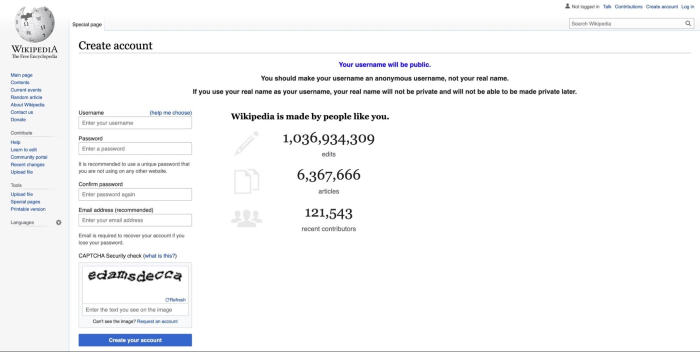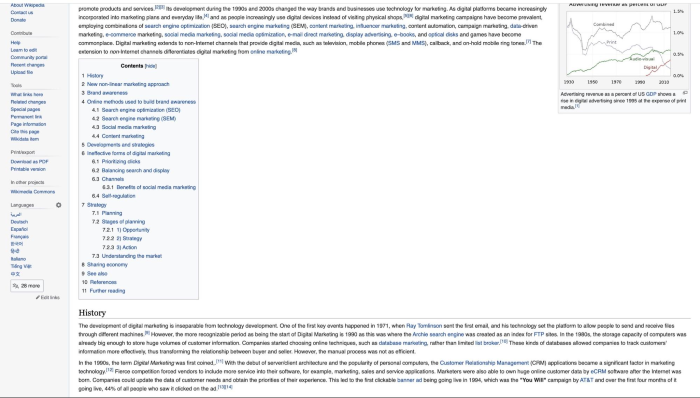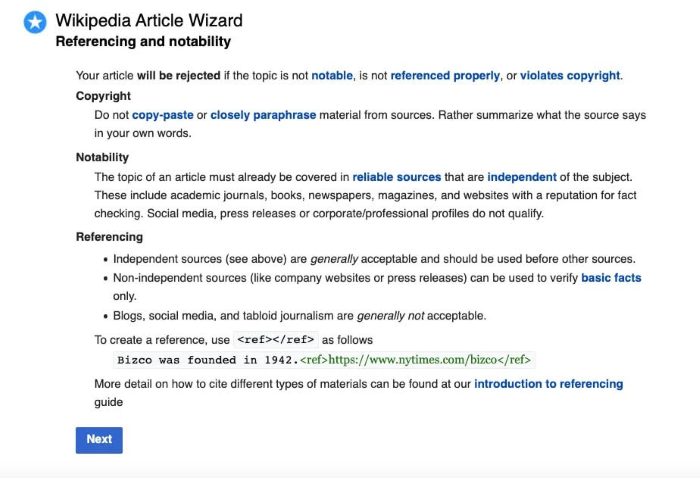
Wikipedia is an ever-evolving, user-generated encyclopedia that allows users to add content, including pages, articles, and general knowledge. Topics span from pinball to Prometheus and everything in between.
If you’re interested in creating a Wikipedia page for your business or marketing endeavors, you should know upfront that getting a page added to the encyclopedia is notoriously challenging.
With a slew of rules that determine what content can be added to the site and the sheer effort of writing a highly-researched page about your business, creating a Wikipedia page is no easy feat.
To help guide what content does end up on the platform, Wikipedia has five pillars to guide creators as they build content for the platform:
- Wikipedia is an encyclopedia.
- Wikipedia is written from a neutral perspective.
- Wikipedia is free, editable, usable, and distributable by all.
- Respect and civility must guide interactions among Wikipedia editors.
- The platform has no firm rules, only guidelines and policies.
After a page is published, volunteer editors are deputized to edit and add to the page for the duration of its existence.
Although those guidelines may seem daunting, there are big benefits for marketers and business owners who manage to make the encyclopedia work in their favor.
The largest benefit of Wikipedia is its sheer size and reach. The encyclopedia averages over 2.5 billion unique visitors per month, earning it the title of one of the most visited sites in the world.
In addition to the sheer magnitude of users, the platform offers other benefits to marketers and business owners:
- Earn traffic and drive backlinks to your site: When you become an active contributor on Wikipedia and start optimizing content, you can identify pages that are relevant to your audience. Search for relevant articles with broken links and those with missing citations, then use links to your site to update those pages. When you add appropriate links in the right spot, you’ll score backlinks and drive traffic to your website.
- Guide to your services and offerings: Given the structure of a Wikipedia page, you can provide readers with basic information like your brand story, location, and executive list. You can also include numbered lists of your services and offerings that allow interested parties a top-of-funnel interaction with your products. Through direct linking, you can then drive to the respective pages on your website.
- Build credibility: While Wikipedia is not a valid source for scholarly research given its user-generated nature, there’s no denying that people flock to the platform for information. By building a page for your organization on the site, you can further develop your credibility as an established company.
As we’ve discussed, publishing your page on Wikipedia can be a complex process. However, the benefits far outweigh the challenges.
In this post, we break down the ten steps on how to create a Wikipedia page.
1. Create an Account
The first step in your journey to creating a Wikipedia page is registering an account on the platform.
While starting an account enables you to create pages, it has other benefits, including:
- access a permanent user page where you can share a brief bio and a few photos
- access a talk page where you can interact with other users
- build your reputation as a Wikipedia author
- customize the ways your pages appear
To register an account, complete this form.

After you’ve completed this step, you’re on your way to your first Wikipedia page.
2. Contribute to Existing Accounts
While Wikipedia is home to exclusively user-generated content, to build credibility on the site, you should contribute to existing accounts and pages.
You can do this by editing existing entries regularly for clarity, factuality, and reliability. To do so, you need to first create a user page.
As you engage more with improving content, you can boost your credibility on the site, increasing the likelihood that, when the time comes, your page will stand a fighting chance of getting published.
3. Verify a Page Doesn’t Already Exist
Perhaps you’re an expert on a particularly niche topic that you’re certain no one has tackled in the expansive landscape that is Wikipedia.
Regardless of how unique you perceive your topic to be, you should still dig to determine whether someone has already staked their flag in your topic.
Use the search bar to explore any pages that may be related to your intended topic.
4. Check Your Topic’s Notability
Unique to Wikipedia, notability is a test editors use to determine whether a topic is substantial or relevant enough to need a unique article.
To earn this title of notable, the information on your page must use reliable, independent sources. In general, a topic needs to meet two specific qualifications to be deemed worthy of a stand-alone page: general notability and subject-specific notability.
If your topic meets these two guidelines, you’re a step closer to actually getting your Wikipedia page published. However, editors can still opt to merge related topics, eliminating the need for a stand-alone page.
5. Research Your Topic and Gather Resources
Before diving into writing your Wikipedia page, be sure to fully research your topic. Whether you’re building a page for your business or developing an adjacent industry topic, be sure to include both internal and external sources to ensure that you are solidifying your reliability and notability in your draft.
6. Create an Outline
After you’ve gathered your research sources, build an outline for your page. Here, break your information into digestible sections that can be indexed through the site’s table of contents that accompany every page.

7. Write a Draft of Your Wikipedia Page
Take your time as you write your Wikipedia page. You want your content to be thorough, thoughtful, and helpful, providing searchers with what they want to know. While Wikipedia pages can do a lot to benefit your marketing efforts, keep in mind that the true intent of the platform is encyclopedic and impartial.
8. Add Citations
Incorporating citations into your Wikipedia page is vital to your page’s success. Citations are the vehicle that drives searchers to trust the information you share on your page.
Before you start creating your page, Wikipedia shares the disclaimer that: “The topic of an article must already be covered in reliable sources that are independent of the subject. These include journals, books, newspapers, magazines, and websites with a reputation for fact-checking. Social media, press releases, or corporate/professional profiles do not qualify.”

We’ve talked a lot about credibility in this blog post—by using reliable citations, you can boost your overall credibility.
9. Submit Your Article for Review
After you’ve written and proofed your page, it’s time to submit your article to Wikipedia for review. This process can take anywhere from a few days to a few weeks to get the go-ahead from Wikipedia.
As we mentioned earlier, publishing on Wikipedia is notoriously challenging; you may have your page or article rejected a few times for finally gaining approval.
10. Continue Making Improvements
Once you’ve completed your page and gained approval, it’s not time to rest on your laurels. As your page gains traction on Google, you must conduct regular updates to ensure it provides the most relevant information about your offerings.
Frequently Asked Questions About How to Create a Wikipedia Page
Should I Build a Wikipedia Page for My Business?
Yes, you should absolutely build a Wikipedia page for your business (or for a client’s business). When you build a page, you earn benefits that include a boost in both search and backlinks, increased credibility, and more traffic.
In addition to these benefits, you can anticipate more exposure for your business given the sheer number of users searching Wikipedia daily.
Is Creating a Wikipedia Article Challenging?
It can be, yes. Not only does your page have to adhere to a number of guidelines set by Wikipedia, but you also must write a comprehensive, research-driven article about your topic or business.
How Can I Know If My Wikipedia Page Will Be Published?
If you adhere to the guidelines established by Wikipedia and ensure your content is not duplicative, you have a good chance of getting your page published. However, we will note that the creation of a Wikipedia page takes a lot of work. Essentially, you are creating a well-researched document that details your organization’s history, mission, and offerings.
How Long Will My Wikipedia Article Be Under Review Before Publication?
While we wish there were a straightforward answer to this question, publication review time varies from page to page, spanning a couple of days to several weeks.
How to Create a Wikipedia Page: Conclusion
Whether you’re looking to increase traffic to your website, improve your search engine optimization, or simply build credibility, Wikipedia is a great outlet.
Through a number of strategies, marketers can make the user-generated encyclopedia work to their benefit, doing much more than simply providing information to interested parties.
As you begin to learn how to create a Wikipedia page, keep in mind that the process may be complicated. For your page to be approved, you need reliable sources that stack up to imbue credibility in your page.
However, regardless of how long the process takes, the end product will be well worth it.
What strategies have you used for marketing on Wikipedia?
from Blog – Neil Patel https://ift.tt/38YGtdm

No comments:
Post a Comment